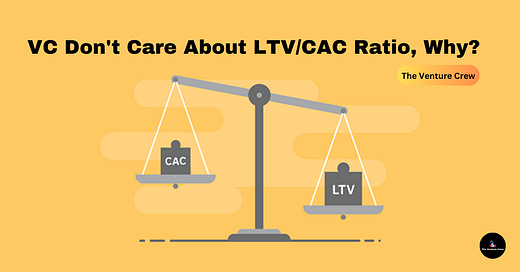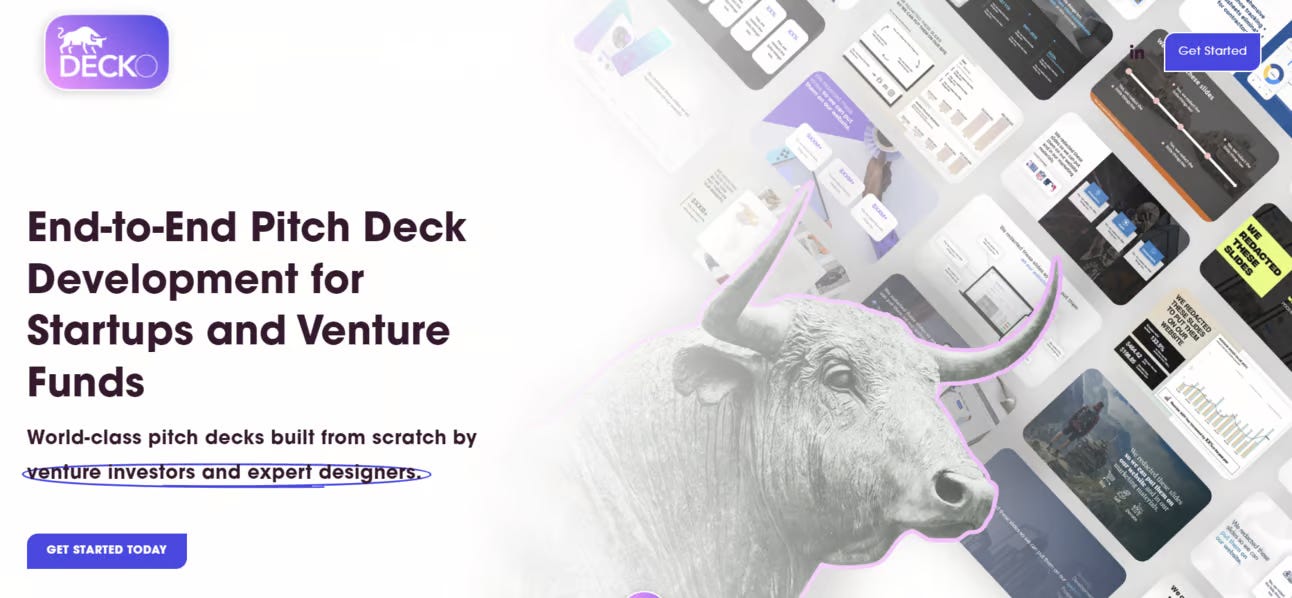VC Don't Care About LTV/CAC Ratio ? | Hacking the VC process: Maximise Your Chance Of Getting Funded | VC Remote Jobs and More
VC Don't Care About LTV/CAC Ratio? | Hacking the VC Process: Maximise Your Chance Of Getting Funded | VC Remote Jobs
📢 Today At A Glance
Focus On: VC don’t care about LTV/CAC Ratio. Why?
Featured Article: Hacking the VC process: Maximise Your Chance Of Getting Funded.
Major News In Startups: Ex-Google Ventures CEO Launched $525M VC Fund, This AI Startup Raised $1.7 Billion To Acquire Another AI Startup & More
This Week’s Must Reading on Startups, Venture Capital & Technology
Venture Capital Remote Jobs & Internships: From Scout to Partner
🤝In Partnership With: Decko
Get Your Pitch Deck Ready With Decko 💡
I wanted to share about an amazing platform called DECKO! If you are a founder & raising a fund for your startup, they can help you.
Decko has an experienced team that helps you create top-notch pitch decks by connecting you with experienced VC investors who shape your content.
Trust me, I have worked with Decko’s Founder and if you are raising funds for your startup, Decko's will be great for you!
📢 VC Don’t Care About LTV/CAC Ratio. Why?
After reading this title you might be thinking it’s clickbait, right? VCs do care about Life time value (LTV) / Customer Acquition Cost (CAC)? OR CAC < LTV. Actually they don’t care about this ratio. What! Why? Let’s deep dive into this.
A business is an engine that attracts customers, delivers something of value to them, and then extracts that value in the form of profits. That’s what a business is. Thus it logically follows that the cost of attracting a new customer needs to be less than the value we can extract from that customer. If it costs us $15 in advertising to get a customer, and we can only make $7 from them then Houston, we have a problem. But if it costs $15 to get them, and then once they are a customer they make a bunch of repeat purchases that yield $75 in profit, then we are happy. Ultimately every venture of every kind has to have a Customer Acquisition Cost (CAC) that is less than the Lifetime Value (LTV) of a customer. It’s a simple, self-evident concept.
Yet it’s a leading cause of startup death.
A high percentage of startups die because their cost of getting customers turns out to be higher than they can make from them. Partly this is just because we’re all optimists — we all think our startup is so awesome that people will flock to become customers and they will remain customers forever. But eventually, that optimism fades as we realize that marketing is expensive and no customer stays forever. The immutable laws of economics set in, and at some point, many startup founders find that their LTV/CAC ratio is slowly draining their bank account.
To paraphrase Ernest Hemingway, Startups go broke two ways: gradually, and then suddenly.
Investors tend to obsess over the LTV/CAC ratio.
Obviously, investors care about your LTV/CAC ratio because it’s the essence of a successful business. But it’s also a proxy for the potential ROI of their investment. If you have proof that you can spend $1 on customer acquisition activities and get $5 in value back (an LTV/CAC ratio of 5.0), investors will want to shovel as much money as possible into that engine. Most of the VCs look for ‘just-add-money opportunity.’ Having a business with an LTV/CAC ratio of over 5.0 looks like a “just-add-money opportunity” to investors.
But it’s a blunt tool that is better if sharpened.
Let’s say that during the quarter we spent $10,000 on sales and marketing and got 1,000 new customers — a CAC of $10. But probably some of those customers came through word-of-mouth, some came as referrals, some came from our PR efforts, and some came from paid advertising. So we had a blended CAC of $10, but that doesn’t tell us anything about the relative effectiveness of each of our different customer acquisition efforts. Which leads me to the next point:
Not all customers are created equal.
With every business I’ve ever run, I’ve realized at some point that 80% of our profits were coming from 20% of our customers. It’s amazing how this tends to be true with almost all businesses. So if we look at the LTV (Lifetime Value) of our entire universe of customers, we’ll probably see that 20% of them have a much higher individual LTV than the rest. Wouldn’t we want to focus our CAC efforts on getting more of the high-LTV customers? Yes, we would.
Therefore, cohorts matter.
The two points above would indicate we really want to track the LTV/CAC ratio by customer cohort. For example, what’s the ratio of customers acquired through Facebook advertising vs those acquired through Google advertising? Knowing that would tell us a lot about how we should allocate advertising dollars. What’s the LTV/CAC ratio for customers acquired through our referral program? Knowing that would tell us how much we can afford to offer in a referral fee. Knowing your company’s blended LTV/CAC tells you the health of the overall engine, but it doesn’t tell you how to optimize the engine’s performance for the next quarter. Tracking customer cohorts tells you that.
Also, velocity matters.
But do you know? - most of the VC don’t care about the LTV/CAC ratio, what they cares about is the velocity with which invested CAC comes back in the form of LTV.
They Generally used CACD than CAC — the D is for “doubled”. CACD answers the question, “If we spend $12 in customer acquisition activities, how long does it take for us to get $24 back?” As an investor, he wants to see a business with a CACD of less than eight months. This formula gets to the heart of an inherent flaw in the LTV/CAC ratio: it doesn’t include a time factor. A business with an LTV/CAC ratio over 5.0 might seem good at first, but if you have to service a customer for 10 years before you make back the money you spent getting him, then it doesn’t seem so good, right?
Velocity matters. So think about how you can measure CACD for your business. Putting $12 somewhere where it returns with a high velocity will accelerate your engine of growth.
That’s it! So, from now it’s not LTV or CAC it’s LTV & CACD.
Join 5900+ Founders, VCs and startup Enthusiasts Getting Tactical To Build, Learn and Implement Startups, Technology and Venture Capital.
Featured Article:
Hacking the VC Process: Maximise Your Chance Of Getting Funded.
Recently I came across an article on “How can founder maximize their chance of getting funded” by Henrik Wetter Sanchez, Partner at Playfair Capital. It’s one of the goldmine articles I read that include more practical approaches. So sharing a summary and key points that I think you can follow to secure the funding:
Source: Medium Article Page
The first important thing in this is to secure a call with the investor. LinkedIn is your secret weapon. You can use it to find investors that match your startup like a missing puzzle piece. And here’s the trick – personalized messages. Forget those generic emails! Craft each message with care, mentioning their past investments and why your startup aligns with their vision. It's like making a tailored suit – fits perfectly!
Events are like treasure troves of opportunities. Attend as many as you can. You never know which connection might lead to your pot of gold. And angel investors? They're not just funding sources; they are your backstage pass to the VC world. They not only invest but also introduce you to the big players. Priceless, right?
Now, let’s talk about those nerve-racking calls. Picture it like a heart-to-heart chat. Your story? It's your magic spell. Paint a vivid picture of your startup’s future, and sprinkle it with real achievements. Investors love a good story backed up by solid proof.
And here’s the secret handshake: speak their language. VCs have their own lingo, and if you talk the talk, they’ll know you mean business. Understand their processes, from the first hello to the final handshake. Knowledge is power, my friend.
But ah, the red flags! VCs dream big, so when you talk numbers, think galaxies, not ponds. And when you pitch, be clear and crisp. No rambling – think elevator pitch, not a novel. And honesty? It’s your best policy. If you’re honest from the get-go, trust me, it goes a long way.
Now, the million-dollar question: what if you face rejection? It stings, but here’s the thing – it’s not always about you or your idea. Sometimes, it’s just not the right fit, like trying to fit a square peg in a round hole. Brush it off, learn from it, and keep moving forward.
If you want to read the full article - here is the link.
📰 This Week’s Major News: VC & Massive Funding Updates
Ex-Google Ventures CEO Launched $525M VC Fund Read Here
This AI Startup Raised $1.7 Billion To Acquire Another AI Startup Read Here
The global VC market continues to stumble but Europe is proving contrary to the trend Read Here
Health IQ Backed by A16Z Bankrupt Read Here
Down rounds are rising. History shows things could get much worse Read Here
Subscribed To, VC Daily Digest Newsletter and join 2600+ Avid Readers For Daily Morning Venture Insights, Funding Updates And Startup Stories In Your Inbox. 🚀
🗞️ This Week’s Read On: Startup, Technology & VC
Mastering the Art of VC Portfolio Management: Strategies for Hitting Grand Slams in the Risky World of Startups Read More (Venture Capital )
Harvesting the Future: The Rise of Artificial Intelligence in Agriculture Read More (Startups)
Generative AI and intellectual property Read More (Emerging Technology)
Understand All About SAFE Read More (Startups)
Hidden Clauses In The Term Sheet that Every Founder Should Know Read More (Venture Capital)
SaaS Competitive Advantage Through Elegant LLM Feedback Mechanisms Read More (AI)
SaaS M&A multiples at 7.7x Read More (Startups)
Decoding Sequoia Capital: How Do They Dominate the VC Landscape? Read More (Venture Capital)
💼 Venture Capital Remote Jobs & Internships
AI & Digital Tools Intern - Analyst Internship | Remote - Apply Here
Curie - Investment Diligence and Operation Lead | Remote - Apply Here
Supply Change Capital - Senior Investment Associate | Remote - Email Here
Fintech and Consumer Investors - Cannan Venture | Remote - Apply here
Investment Manager - Circulate Capital | Remote - Apply Here
Venture Capital Intern - BGV | Remote - Email Here
Pulsar VC - VC Fellow | Remote - Apply Here
Join our VC Enthusiast Community - VC Crafters - A Community For VC Enthusiasts To Learn, Collaborate, Network and Craft Path To VC.
You’ll get access to:
All-in-one VC career resources | Weekly Networking Events | Weekly Sessions By Investors/Founders | VC/Resume Review and interview Preparation Help | Daily Discussion Session On Various Topics | 1:1 on-demand sessions with VC Professional | Daily VC job updates | Exceptional / Active Member - Recommend to VC Firm’s Recruiters
📦 Share VC’s Newsletter
Refer a friend to gain access to our venture resources. 🎊
Get Venture Capital and Investors Database. for 4 referrals
Get Access To private Slack for 10 referrals
Get On a 30-minute call for 15 referrals ( To Discuss fundraising, breaking into VC funds, making a pitch deck, building a newsletter and others)
✍️Written By Sahil | The Venture Crew Team










